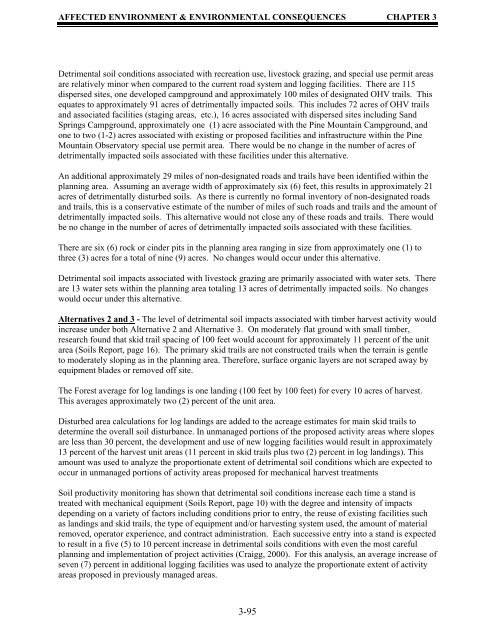Environmental Assessment
Environmental Assessment
Environmental Assessment
Create successful ePaper yourself
Turn your PDF publications into a flip-book with our unique Google optimized e-Paper software.
AFFECTED ENVIRONMENT & ENVIRONMENTAL CONSEQUENCES CHAPTER 3<br />
Detrimental soil conditions associated with recreation use, livestock grazing, and special use permit areas<br />
are relatively minor when compared to the current road system and logging facilities. There are 115<br />
dispersed sites, one developed campground and approximately 100 miles of designated OHV trails. This<br />
equates to approximately 91 acres of detrimentally impacted soils. This includes 72 acres of OHV trails<br />
and associated facilities (staging areas, etc.), 16 acres associated with dispersed sites including Sand<br />
Springs Campground, approximately one (1) acre associated with the Pine Mountain Campground, and<br />
one to two (1-2) acres associated with existing or proposed facilities and infrastructure within the Pine<br />
Mountain Observatory special use permit area. There would be no change in the number of acres of<br />
detrimentally impacted soils associated with these facilities under this alternative.<br />
An additional approximately 29 miles of non-designated roads and trails have been identified within the<br />
planning area. Assuming an average width of approximately six (6) feet, this results in approximately 21<br />
acres of detrimentally disturbed soils. As there is currently no formal inventory of non-designated roads<br />
and trails, this is a conservative estimate of the number of miles of such roads and trails and the amount of<br />
detrimentally impacted soils. This alternative would not close any of these roads and trails. There would<br />
be no change in the number of acres of detrimentally impacted soils associated with these facilities.<br />
There are six (6) rock or cinder pits in the planning area ranging in size from approximately one (1) to<br />
three (3) acres for a total of nine (9) acres. No changes would occur under this alternative.<br />
Detrimental soil impacts associated with livestock grazing are primarily associated with water sets. There<br />
are 13 water sets within the planning area totaling 13 acres of detrimentally impacted soils. No changes<br />
would occur under this alternative.<br />
Alternatives 2 and 3 - The level of detrimental soil impacts associated with timber harvest activity would<br />
increase under both Alternative 2 and Alternative 3. On moderately flat ground with small timber,<br />
research found that skid trail spacing of 100 feet would account for approximately 11 percent of the unit<br />
area (Soils Report, page 16). The primary skid trails are not constructed trails when the terrain is gentle<br />
to moderately sloping as in the planning area. Therefore, surface organic layers are not scraped away by<br />
equipment blades or removed off site.<br />
The Forest average for log landings is one landing (100 feet by 100 feet) for every 10 acres of harvest.<br />
This averages approximately two (2) percent of the unit area.<br />
Disturbed area calculations for log landings are added to the acreage estimates for main skid trails to<br />
determine the overall soil disturbance. In unmanaged portions of the proposed activity areas where slopes<br />
are less than 30 percent, the development and use of new logging facilities would result in approximately<br />
13 percent of the harvest unit areas (11 percent in skid trails plus two (2) percent in log landings). This<br />
amount was used to analyze the proportionate extent of detrimental soil conditions which are expected to<br />
occur in unmanaged portions of activity areas proposed for mechanical harvest treatments<br />
Soil productivity monitoring has shown that detrimental soil conditions increase each time a stand is<br />
treated with mechanical equipment (Soils Report, page 10) with the degree and intensity of impacts<br />
depending on a variety of factors including conditions prior to entry, the reuse of existing facilities such<br />
as landings and skid trails, the type of equipment and/or harvesting system used, the amount of material<br />
removed, operator experience, and contract administration. Each successive entry into a stand is expected<br />
to result in a five (5) to 10 percent increase in detrimental soils conditions with even the most careful<br />
planning and implementation of project activities (Craigg, 2000). For this analysis, an average increase of<br />
seven (7) percent in additional logging facilities was used to analyze the proportionate extent of activity<br />
areas proposed in previously managed areas.<br />
3-95
















